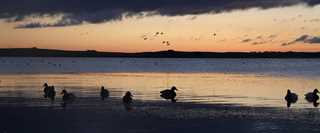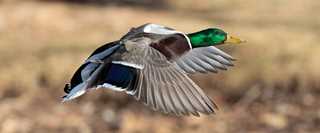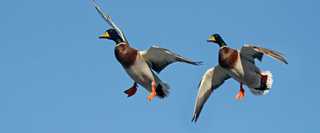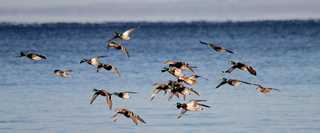5 Central Flyway Public Waterfowl Hunting Destinations for 2017-2018
Five potential public-land hotspots for waterfowling
Five potential public-land hotspots for waterfowling
.jpg)
By John Pollmann
Millions of waterfowl funnel through the Central Flyway each fall, offering hunters a variety of opportunities to target both ducks and geese. The quality of the hunting is considered to be some of the best that North America has to offer, and much of it can be found on public land. Following are five of the Central Flyways best public hunting areas where you may want to find yourself this season.

Photo Michael Furtman
The 18,000 acres of federally managed Waterfowl Production Areas found in the Crosby Wetland Management District (WMD) in northwestern North Dakota are a top destination for those hunters who enjoy decoying mallards, pintails and other puddle ducks over prairie wetlands.
The combination of these wetlands with the availability of food in the region help hold locally raised birds in September and October, while also attracting migrating waterfowl as the season progresses, explains Scott Williams, program manager of the Crosby WMD, which is a part of the U.S. Fish &Wildlife Services national wildlife refuge system.
There are 99 Waterfowl Production Areas in the Crosby WMD, varying from just over 10 acres to over 2000 acres in size. Early season hunts in these wetlands in this corner of the Prairie Pothole Region are highlighted by a variety of species that hunters can expect to see on the wing, Williams says, adding that many waterfowl hunters will take advantage of the upland bird hunting found in the area before the weather turns cold.
The late-season hunting tends to focus more on mallards, which use the wetlands as staging ponds before hitting the field peas or wheat, says Williams. This part of the season is high-risk, high-reward, however, as a cold front can send ducks in the area and those still built up north in Canada south in a hurry.
For more information about hunting in North Dakota, visit https://gf.nd.gov/

Photo Michael Furtman
The late-season waterfowl hunting found on Nebraskas river systems is legendary, and this includes the public hunting opportunities found on the stretch of the Missouri River that forms the states northeastern border.
When the conditions are right, the gunning for mallards and Canada geese is second to none, says veteran river hunter and host of Drakes Migration Nation Barnie Calef.
When things get really cold in the Dakotas and the potholes freeze, the Missouri River heats up, says Calef. But this means that you are going to be hunting in some pretty tough conditions, including freezing temperatures and ice. Add this on top of a river that has a big current, and things can get dangerous.
Calef recommends having extra gas on board and a spare tank of propane if the boat is equipped for heat, as well as an aerial map of the area or a handheld GPS. And a big, sturdy boat equipped with large horsepower motors is an absolute must when the Missouri River starts running ice.
On days of heavy ice, be prepared to have a back-up plan, as you may not be able to access some of the more remote pockets of water, says Calef. Some of my best hunts have been on these days, using a combination of duck and goose full-bodies on a sandbar just off the main channel and out of the ice flow.
For more information about hunting in Nebraska, visit http://outdoornebraska.gov/hunting/

Photo Michael Furtman
The Conservation Reserve Enhancement Program (CREP) in South Dakota is a habitat initiative that targets acres of sensitive ground in the James River watershed. In exchange for a higher rental rate, those landowners who participate must also open the ground to public access for hunting.
The program is extremely popular with pheasant hunters, but Rocco Murano, chief waterfowl biologist for the South Dakota Game, Fish and Parks (SDGFP), says that CREP acres in the northeast corner of the state should not be ignored by those who like to hunt puddle ducks over decoys.
Many of these CREP areas in the upper reaches of the James River watershed include wetland basins, even some larger sloughs, that when water levels are good theyre sure to be holding mallards, gadwall, blue-winged teal and other puddle ducks, says Murano. And if you hunt them before pheasant season starts up, you probably wont see much for other hunting pressure.
In general, Murano believes that hunting ducks over water on public ground in the state does not get the attention it deserves.
So much emphasis is being placed on field hunting mallards these days that I think hunters are missing out on shooting both puddlers and divers over water, says Murano. Part of what makes duck hunting so much fun is seeing the variety of birds over your decoys, which is something you can experience when you hunt over water.
For more information about hunting in South Dakota, visit http://gfp.sd.gov/hunting/

Photo Michael Furtman
Among the Wildlife Areas managed by the Kansas Department of Wildlife, Tourism and Parks (KDWTP) are those that contain the shallow, food-rich wetlands that attract droves of migrating waterfowl. Not surprisingly, the public hunting opportunities found on these waterfowl magnets scattered across the state have helped turn Kansas into a top destination for waterfowl hunters.
Hunters shouldnt expect to have the marsh to themselves, explains KDWTPs waterfowl project leader, Tom Bidrowski, so a little extra effort is needed to stay successful.
Avoiding the weekend crowds helps, Bidrowski says, as well as monitoring both in-state and flyway-wide weather and migration patterns.
Those hunters that have the most success are those who have done their homework, Bidrowski says.
Jason Wagner, a KDWTP wildlife manager, agrees, adding that it also pays to think outside the box when it comes to hunting techniques.
You have to do something different than everyone else in order to stand out in the crowd, says Wagner. That can mean using a very small decoy spread of only two or three blocks or going the other direction by using a large spread of ten dozen or more decoys. Using a jerk-string or other non-motorized method of creating motion in the decoys is also a good idea. And some days the absolute best thing you can do is leave your duck call in your pocket and not make a sound. It is all about trying something different than the others on the marsh.
For more information about hunting in Kansas, visit http://ksoutdoors.com/Hunting

Photo Michael Furtman
Oklahoma may not be the first state that comes to mind when thinking of waterfowl hunting on public ground, but there are tremendous opportunities for a variety of waterfowl species on land across the state that is accessible to the freelance hunter. While the states river systems and reservoirs receive a lot of attention, the intensively managed Wetland Development Units are perhaps most popular with waterfowl and hunters.
The diversity of wetlands and variety of food available on these units are what help attract migrating waterfowl, explains J.D. Ridge with the Oklahoma Department of Wildlife Conservation. For hunters planning on visiting one of the units, the best thing to do is stay on top of what is happening in that specific area in terms of bird numbers and the weather. Call ahead and do some homework.
Mallards are a top target of hunters at the different Wetland Development Units, but Ridge advises to be prepared to take advantage of other options, especially if the temperatures drop.
A cold snap will ice things up in the shallow wetlands where mallards are feeding and loafing pretty quickly, so it is wise to be prepared to hunt larger water, says Ridge. The good news is a hunter is likely to see a wider variety of waterfowl species on these bigger wetlands and lakes.
For more information about hunting in Oklahoma, visit https://www.wildlifedepartment.com/